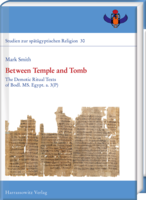|
|
more titles of the subject:
Please note: With adding digital Products to your cart
the payment will be handled via PayPal. The download will be provided after the payment is confirmed. The ancient Egyptians believed that rites performed for Osiris, the god of the dead, played a critical role in maintaining Egypt’s well-being and prosperity. Not only did they ensure the renewed fertility of the country’s arable land, they also guaranteed the political and social cohesion of the Egyptian state. However, it was not only at the national level, but at the individual level as well, that the Egyptians deemed such rites to be beneficial. Ritual texts intended to restore Osiris to life, suitably adapted, could also be recited for deceased individuals. Thus they could benefit from them in the same way that Osiris did. In the Graeco-Roman Period, adapted ritual texts of this sort were employed alongside texts originally composed for use in the funerary cult of ordinary deceased people. A number of ritual texts which are first attested in the private sphere subsequently appear in the temple sphere as well. Some ritual texts appear to have moved back and forth from one sphere to another, which suggests that the boundaries between the Osirian temple cult and the private funerary cult may have been more fluid than we usually imagine.
The ritual texts edited in this volume offer an excellent opportunity to explore these and related issues. Most of them are known to have been employed both for the benefit of the god Osiris and for ordinary deceased people, in certain cases, during one and the same period of Egypt’s history. This is one of their most interesting and striking features. They stand at the interface between temple cult and cult of the dead and allow us to trace the transmission of beliefs and practices from one sphere to the other. |
|||||||||||||||||||||||||||||||||||||||






